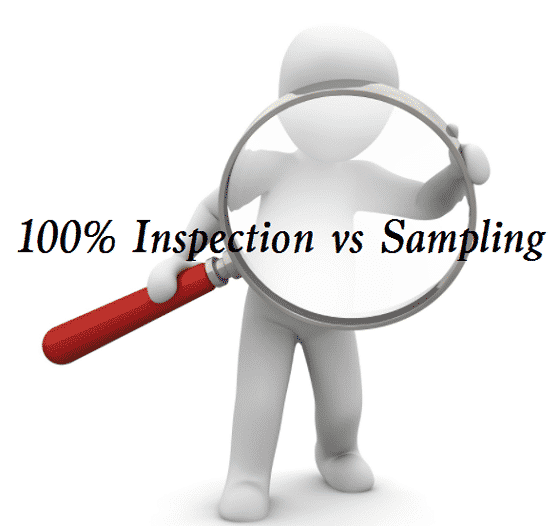In order to ensure the quality of a batch of products, it is necessary to make judgments through sampling and testing of samples. Product quality inspection can generally be divided into 100% inspection and sampling inspection.

What is 100% Inspection?
100% inspection is to inspect each unit of products in a batch of products submitted for inspection one by one, determine whether each unit of products is qualified or unqualified, and pick out unqualified products. 100% inspection is relative to the sample inspection. If there are too many problems in the sampling inspection report, the customer may worry that other parts of this batch of goods also have these problems. Then, the factory may be required to hand over all products to a third-party inspection company for 100% inspection. The goods will not be accepted until the 100% inspection report meets the requirements.
Features of 100% Inspection:
- Requires careful inspection
- More number of inspections needed
- One of the most accurate inspection
- No sampling error exists
- Inspection errors may arise due to fatigue, negligence, and difficulty in supervision
What is Sampling Inspection?
Sampling inspection is to randomly select an appropriate amount of products as samples from a batch of products submitted for inspection according to the specified sampling plan, conduct 100% inspection of the samples, and judge whether the whole batch of products is qualified or unqualified according to the inspection results of the samples. Sampling inspection is applicable to the situations of destructive inspection, large production batch, low product value, time-consuming inspection, and high inspection cost. In essence, the number of samples taken to inspect a batch of products does not depend on the product batch, and the number of samples depends on the uniformity of the distribution of the quality characteristics of the products to be inspected. The more uniform the distribution of product quality characteristics, the fewer samples are needed. On the contrary, the more uneven the distribution of product quality characteristics, the more samples are needed. The distribution uniformity of product quality characteristics is mathematically expressed by variance. The larger the variance, the more uneven the distribution of product quality characteristics. Therefore, the most important thing in sampling inspection is to draw samples randomly according to the sampling scheme specified by product quality characteristics and certain rules. Whether these two basic parts are scientific or not determines the scientificity of sampling inspection results.
Features of Sampling Inspection:
- Inspects a small number of items
- Take a sample from a batch
- Results of the sample are used to accept or reject the sample
- Accept/Reject criteria are based on the number of defectives found in the sample
- Most useful when the product testing is expensive or time-consuming
100% Inspection vs Sampling Inspection, Which Inspection Method to Use?
100% inspection is only applicable to the qualified batch after inspection. There are no unqualified products, small production batch, low inspection cost, and few inspection items, and the inspection should be non-destructive. Based on the above factors, 100% inspection has great limitations. For example, when the product output is large, there are many inspection items and the inspection is complex, it is necessary to spend a lot of manpower and material resources to carry out a 100% inspection, and when the quality inspection is destructive, a 100% inspection is even more impossible. Therefore, people use the sampling inspection method more in daily quality inspection.
In addition, it is not certain that 100% full inspection will reliably detect all nonconformities. It has been proved that the inspection error may be greater than that of sampling inspection due to the large inspection workload, monotonous repetition, and long time.
How to do 100% inspection
When 100% of products are produced, before or after the product packaging, inspect the appearance, workmanship, function, safety, and inspection points of each product in the factory or warehouse according to the requirements, strictly distinguish good products from bad products and summarize the inspection results. After the inspection, the good products shall be packed and sealed with special tape, and the bad products will be returned to the factory with the details of the bad products. 100% inspection before shipment, also known as “100% inspection”, is a quality control service specially provided for domestic and foreign customers and e-commerce platform merchants with demand.
How to do sampling inspection
When the products are 100% finished, at least 80% packaged, and ready for shipment, sampling inspection shall be carried out according to the international sampling plan; Take samples randomly from finished products and check them according to customers’ orders, product requirements and reference samples to ensure that the final products meet customers’ requirements.